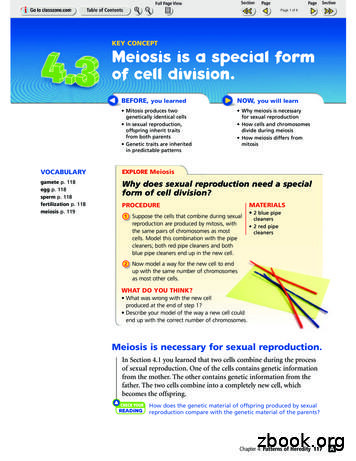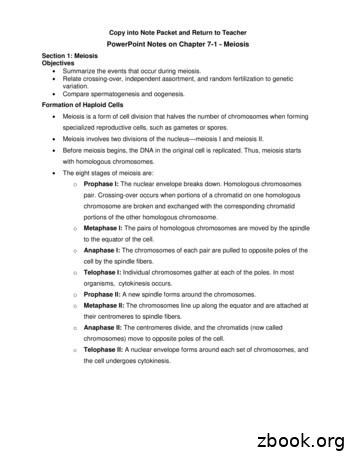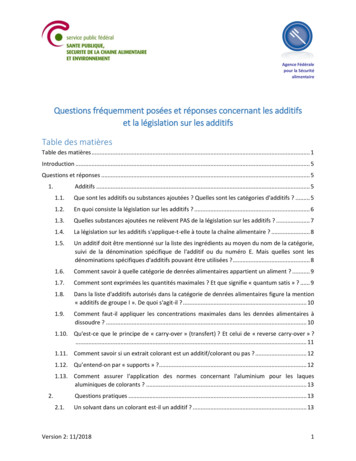Meiosis Is A Special Form Of Cell Division.
Page 1 of 6KEY CONCEPTMeiosis is a special formof cell division.BEFORE, you learnedNOW, you will learn Mitosis produces twogenetically identical cells In sexual reproduction,offspring inherit traitsfrom both parents Genetic traits are inheritedin predictable patterns Why meiosis is necessaryfor sexual reproduction How cells and chromosomesdivide during meiosis How meiosis differs frommitosisVOCABULARYEXPLORE Meiosisgamete p. 118egg p. 118sperm p. 118fertilization p. 118meiosis p. 119Why does sexual reproduction need a specialform of cell division?MATERIALSPROCEDURE1Suppose the cells that combine during sexualreproduction are produced by mitosis, withthe same pairs of chromosomes as mostcells. Model this combination with the pipecleaners; both red pipe cleaners and bothblue pipe cleaners end up in the new cell. 2 blue pipecleaners 2 red pipecleaners2 Now model a way for the new cell to endup with the same number of chromosomesas most other cells.WHAT DO YOU THINK? What was wrong with the new cellproduced at the end of step 1? Describe your model of the way a new cell couldend up with the correct number of chromosomes.Meiosis is necessary for sexual reproduction.In Section 4.1 you learned that two cells combine during the processof sexual reproduction. One of the cells contains genetic informationfrom the mother. The other contains genetic information from thefather. The two cells combine into a completely new cell, whichbecomes the offspring.Check Your ReadingHow does the genetic material of offspring produced by sexualreproduction compare with the genetic material of the parents?Chapter 4: Patterns of Heredity 117AE
Page 2 of 6Most human cells, which can be referred to as body cells, contain46 chromosomes—the full number of chromosomes that is normalfor a human being. Any cell that contains the full number of chromosomes (two sets) for a species is a 2n cell, also called a diploid cell. The2n cells for a fruit fly, for example, contain 8 chromosomes.Think about what would happen if two body cells were tocombine. The resulting cell would have twice the normal number ofchromosomes. A special type of cell, called a gamete, is needed.VOCABULARYBe sure to make aword magnet for theterm gamete.Gametes are cells that contain half the usual number of chromosomes—one chromosome from each pair. Gametes are 1n cells, alsocalled haploid cells. Human gametes contain 23 unpaired chromosomes.The gametes of a fruit fly contain 4 unpaired chromosomes. Gametes arefound only in the reproductive organs of plants and animals. An egg is agamete that forms in the reproductive organs of a female. A gamete thatforms in the reproductive organs of a male is a sperm .What is a gamete?During sexual reproduction two gametes combine to become a2n cell that can grow into a new offspring. Fertilization is the processthat takes place when a sperm and an egg combine to form one newcell. The diagram below shows what happens to the chromosomes ingametes during fertilization. In humans, an egg cell with 23 chromosomes joins a sperm cell with 23 chromosomes to form a new 2n cellwith 46 chromosomes.FertilizationDuring fertilization, a 1n egg cell from a femalecombines with a 1n sperm cell from a male, producinga 2n fertilized egg cell, which develops into an offspring.egg cell(female gamete)egg cellfertilizedegg cell1nfertilizationsperm cellssperm cell(male gamete)2nFPO1nAE118 Unit: Cells and Heredity
Page 3 of 6FertilizationSKILL FOCUSHow can you model fertilization?ModelingIn fertilization, a sperm and an egg combineto form a new cell. Design a model of fertilization.MATERIALSPROCEDURE1Use the materials provided to make simple models of an egg and a sperm.2 Use the sperm and egg models to show the fertilization process. pipe cleanersgallon milk jugfilm canisteryarnTIME25 minutesWHAT DO YOU THINK? Describe your model of the cell that exists at the endof the fertilization process. How is it different from the sperm cell and egg cell?CHALLENGE Design a model for fertilization in fruit flies.You know that body cells divide by the process calledmitosis. Mitosis produces two daughter cells, each containing exactcopies of the chromosomes in the parent cell. Each daughter cellformed by mitosis is a standard diploid (2n) cell.But to produce gametes, which are haploid, a different kind of celldivision is necessary. Meiosis is a special kind of cell division thatproduces haploid (1n) cells. During meiosis, a single cell goes throughtwo cell divisions—meiosis I and meiosis II. Meiosis takes place onlyin the reproductive tissues of an organism.Cells divide twice during meiosis.Before meiosis begins, the chromosomes of the parent cell arecopied. A cell that is ready to divide contains two copies of eachchromosome pair—twice as many chromosomes as usual. So toend up with cells that have half the usual number of chromosomes,there must be two divisions.NOTETAKING STRATEGYUse an earlier strategy orone that you think workswell to take notes on thedivision of cells duringmeiosis.Remember that the two chromosomes in a pair are calledhomologs. At the beginning of meiosis I, the cell has two copies ofeach homolog. During meiosis I the homologs divide. The startingcell divides into two cells. One cell contains the two copies of onehomolog of each pair, while the other cell contains the two copies ofthe other homolog of each pair. Then, during meiosis II, each of thetwo cells is divided, producing four haploid cells. Each haploid cell hasone unpaired set of chromosomes.Chapter 4: Patterns of Heredity 119AE
Page 4 of 6Meiosis IAs you can see in the diagram on page 121, there are four stepsin meiosis I: prophase I, metaphase I, anaphase I, and telophase I.Included in telophase I is a cytokinesis, the division of the cytoplasm.The diagram shows what would happen during meiosis I in a speciesthat has four chromosomes in its 2n body cells.reading tipAs you read about meiosis Iand meiosis II, match thenumbers in the text to thenumbers in the diagram onpage 121.Chromosomes pair up with their partners. There aretwo sets of each of the chromosome pairs in the parent cell. Themembers of each chromosome pair are attached together in setsof doubled homologs.1Prophase I2Metaphase I3Anaphase I4Telophase I and CytokinesisEach set of chromosome pairs lines up along thecenter of the cell.The two copies of one homolog are pulled apartfrom the two copies of the other homolog. This dividing of thehomologs is the most significant step of meiosis I.A new cell membrane forms at thecenter of the cell, dividing the parent cell into two daughter cells.Check Your ReadingWhat happens to the parent cell during telophase I?Meiosis IIDuring meiosis I, two daughter cells are formed. The chromosomesRESOURCE CENTERCLASSZONE.COMof these two cells are not copied before meiosis II begins. Both ofLearn more aboutthese cells divide during meiosis II, to produce a total of four daughtermeiosis.cells. The four steps in meiosis II, shown on page 121, are prophase II,metaphase II, anaphase II, and telophase II (with cytokinesis).In each daughter cell, there are two copies of eachof n chromosomes. The copies are attached together.5Prophase II6Metaphase II7Anaphase II8Telophase II and CytokinesisThe chromosomes line up along each cell’s center.The two attached copies of each chromosomeseparate and are pulled to opposite poles in each cell.A new cell membrane forms in thecenter of each cell, as each cell divides into two 1n daughter cells,producing a total of four 1n cells.During meiosis, one cell in an organism’s reproductive systemdivides twice to form four 1n cells. In male organisms, these gametesbecome sperm. In female organisms, at least one of these cellsbecomes an egg. In some species, including humans, only one of thefour daughter cells produced by a female during meiosis becomes anegg. The rest dissolve back into the organism or, in some cases, arenever produced.AE120 Unit: Cells and Heredity
Page 5 of 6MeiosisMeiosis reduces the number of chromosomes by half,producing four 1n cells.Meiosis I: Paired chromosomes separate1Meiosis II: Chromosomes separate5Prophase IProphase IIchromosome(two copies ofone homolog)DNA condenses into chromosomes.The nuclear membrane disappears.2Metaphase Ichromosome pair(two copies ofmatching homologs)The two copies of each homolog remainattached as chromosomes.6Chromosomes line up in the middleof the cell.Chromosomes arrange as pairs in themiddle of the cell.3Anaphase IMetaphase II7Anaphase IIchromatidsThe homologs of each chromosome pairseparate and are pulled to opposite endsof the cell.4Telophase I and CytokinesisEach chromosome splits into chromatids,so that one copy of each homolog ispulled to the opposite ends of the cells.8Telophase II and Cytokinesis1n1n1nThe cell divides into two daughter cells.1nBoth cells divide, producing four 1n cells.Chapter 4: Patterns of Heredity 121AE
Page 6 of 6Meiosis and mitosis differ in someimportant ways.You can see that the processes of meiosis and mitosis are similar inmany ways. However, they also have several very important differences.reading tip As you read about howmeiosis and mitosis aredifferent, refer to thediagrams on pages 83and 121.Only cells that are to become gametes go through meiosis.All other cells divide by mitosis. A cell that divides by meiosis goes through two cell divisions,but the chromosomes are not copied before the second division.In mitosis, the chromosomes are always copied before division. Daughter cells produced by meiosis, which are haploid (1n),contain only half of the genetic material of the parent cell(one of each chromosome).Cell produced by meiosis Daughter cells produced by mitosis, which are diploid (2n),contain exactly the same genetic material as the parent (pairsof chromosomes).Cell produced by mitosisCheck Your ReadingKEY CONCEPTSCRITICAL THINKING1. What kind of cell is producedby meiosis?4. Compare How do prophase Iand prophase II differ?2. What is fertilization?5. Communicate Make a Venndiagram to show the similarities and differences betweenmitosis and meiosis.3. In your own words, describethe differences betweenmeiosis and mitosis.AEWhat are four ways in which meiosis differs from mitosis?122 Unit: Cells and HeredityCHALLENGE6. Synthesize Why doesmeiosis II result in four 1n cellsrather than four 2n cells?
During meiosis, a single cell goes through two cell divisions—meiosis I and meiosis II. Meiosis takes place only in the reproductive tissues of an organism. Cells divide twice during meiosis. Before meiosis begins, the chromosomes of the parent cell are copied. A cell that is ready to divide contains two copies of each
Meiosis is a form of cell division that halves the number of chromosomes when forming specialized reproductive cells, such as gametes or spores. Meiosis involves two divisions of the nucleus—meiosis I and meiosis II. Before meiosis begins, the DNA in the original cell is replicated. Thus, meiosis starts with homologous chromosomes.
Cell Division in Sexual Reproduction: Meiosis Meiosis is the mechanism by which eukaryotic cells produce mature sex cells or gametes Meiosis produces four haploid cells (gametes) Meiosis involves partition of both cytoplasmic and nuclear structures Meiosis consists of Meiosis I and Meiosis II. Both phases are followed by .
TAKING NOTES Draw a Venn diagram like the one below to summarize the similarities and differences between meiosis I and meiosis II. chromo-somes condense divides homologous chromosomes divides sister chromatids Meiosis I Meiosis II 6.2 Process of Meiosis KEY CONCEPT During meiosis, diploid ce
I II III IV A DNA Replication Mitosis Meiosis Fertilisation B DNA Replication Meiosis 1 Meiosis 2 Fertilisation C Fertilisation Meiosis Mitosis DNA Replication D Mitosis Meiosis 1 Meiosis 2 DNA Replication 4.4 In analysing the number of different bases in a DNA sample, the following result would be consistent with the base-pairing rules: .
Meiosis is a process in which the number of chromosomes per cell is cut in half through the separation of homologous chromosomes in a diploid cell. Meiosis usually involves two distinct divisions, called meiosis I and meiosis II. By the end of meiosis II, the diploid cell becomes four haploid cells.File Size: 796KB
II. Process of Meiosis (6.2) A. Cells go through _ rounds of division in meiosis 1. Meiosis produces _ haploid cells from one diploid cell 2. Process involves two rounds of _ _- Meiosis I and Meiosis II. B. Homologous Chromosomes and sister Chromatids 1.
Now that you've seen how meiosis works, let's review two key differ-ences between the processes of meiosis and mitosis. Meiosis has two cell divisions. Mitosis has only one cell division. Meiosis results in haploid cells. Mitosis results in diploid cells. On the diagram above, circle the part in the process of meiosis
alimentaire Version 2: 11/2018 3 2.16. Un additif repris sur la liste des ingrédients d'un fromage n'est pas un additif autorisé dans le fromage. L'additif est toutefois autorisé dans un ingrédient. L'additif peut-il être présent avec























